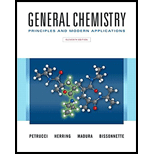
In the production of ammonia, the followingprocessesoccur.
a. Air is liquefied at low temperature and high pressure.
b. The temperature of the liquid air is raised gradually until the oxygen boilsoff. Essentially pure liquid nitrogen remains.
c. Natural gas is treated with steam to produce carbon dioxide and hydrogen. The proportions of the products vary withthe composition ofthe natural gas.
d. Hydrogen and nitrogen (both gases) are combined at high temperature and pressures. They react to form ammonia gas. Some unreacted hydrogen and nitrogen remain.
e. The gases are until the ammonia liquefies, and then the gaseous hydrogen and nitrogen are recirculated to react again.
For each of (a) to (e), indicate whether a physical chemical change occurs, and briefly explain your choice. For each italicized word or phrase, state whether it refers to an element, a compound. a mature. or none of these, and briefly explain your choice.
Want to see the full answer?
Check out a sample textbook solution
Chapter 1 Solutions
GENERAL CHEMISTRY(LL)-W/MASTERINGCHEM.
- Can you please color-code and explain this problem to me and is it because its spdf, and then it follows by higher numver so 3 first and so forth ...arrow_forwardapp aktv.com Alt Leaming App Curved arrows are used to illustrate the flow of electrons. Using the provided starting and product structures, draw the curved electron-pushing arrows for the following reaction or mechanistic step(s). Be sure to account for all bond-breaking and bond-making steps. Problem 30 of 35 Na Select to Edit Arrows THE M 回 Na :0: 0% Donearrow_forwardCan you explain this problem to me? I'm only given a PD table, so how can I determine the answer? I guess there’s a way to subtract the TI-84 EN values.arrow_forward
- Sapp ektiv.com Free Response Work-Aktiv Problem 2 of 35 Your Response Submit Aldehyde electrophiles generally react more quickly than ketones in nucleophilic addition reactions. Explain the difference in reactivity. Make a clear claim about these structures and the characteristics of this reaction. Briefly state the evidence and relate the evidence clearly to your explanation. Type in your prompt for the question. Click "Add Equation/Symbols" to insert symbols and expressions. 回 =Add Equation/Symbols Feb 15 9:54arrow_forwardCan you please color-code and explain how to solve this and any molecular orbital diagram given? I'm so confused; could you provide baby steps regardless of which problem type they gave me?arrow_forwardCurved arrows are used to illustrate the flow of electrons. Using the provided starting and product structures draw the curved electon-pushing arrows for the following reaction or mechanistic steps. Be sure to account for all bond-breaking and bond-making steps.arrow_forward
- Organic Chemistry Lecture Aktiv Learning App app aktiv com Curved arrows are used to illustrate the flow of electrons. Using the provided starting and product structures, draw the curved electron-pushing arrows for the following reaction or mechanistic step(s). Be sure to account for all bond-breaking and bond-making steps. Problem 31 of 35 Na = Select to Edit Arrows CH.CH.CCNa D H 0:0 H :0: Na © Dane 00 Feb 15arrow_forwardDraw the major product of this reaction. Ignore inorganic byproducts. Br Problem 8 of 35 excess Mg, ether Atoms, Bonds and Rings Charges Draw or tap a new bond to see suggestioarrow_forwardgiven only right answer ...arrow_forward
- Curved arrows are used to illustrate the flow of electrons. Using the provided starting and product structures, draw the curved electron-pushing arrows for the following reaction or mechanistic step(s). Be sure to account for all bond-breaking and bond-making steps. NaO :0: Select to Add Arrows THF > Pleaarrow_forwardapp aktv.com Curved arrows are used to illustrate the flow of electrons. Using the provided starting and product structures, draw the curved electron-pushing arrows for the following reaction or mechanistic step(s). Be sure to account for all bond-breaking and bond-making steps. :0: 0:0 H NaO Select to Add Arrows CH3CH2CCNa Problem 31 of 35 Please select aarrow_forwardK Sepp aktiv com Curved arrows are used to illustrate the flow of electrons. Using the provided starting and product structures, draw the curved electron-pushing arrows for the following reaction or mechanistic step(s). Be sure to account for all bond-breaking and bond-making steps. Drawing Arrows CH3CH2OK, CH3CH2OH Altis Learning App 31 Problem 28 of 35 H. :0: H H H H H 0:0 H KO Undo Reset Donearrow_forward
 Introductory Chemistry: A FoundationChemistryISBN:9781337399425Author:Steven S. Zumdahl, Donald J. DeCostePublisher:Cengage LearningChemistry: Matter and ChangeChemistryISBN:9780078746376Author:Dinah Zike, Laurel Dingrando, Nicholas Hainen, Cheryl WistromPublisher:Glencoe/McGraw-Hill School Pub Co
Introductory Chemistry: A FoundationChemistryISBN:9781337399425Author:Steven S. Zumdahl, Donald J. DeCostePublisher:Cengage LearningChemistry: Matter and ChangeChemistryISBN:9780078746376Author:Dinah Zike, Laurel Dingrando, Nicholas Hainen, Cheryl WistromPublisher:Glencoe/McGraw-Hill School Pub Co Chemistry: The Molecular ScienceChemistryISBN:9781285199047Author:John W. Moore, Conrad L. StanitskiPublisher:Cengage Learning
Chemistry: The Molecular ScienceChemistryISBN:9781285199047Author:John W. Moore, Conrad L. StanitskiPublisher:Cengage Learning ChemistryChemistryISBN:9781305957404Author:Steven S. Zumdahl, Susan A. Zumdahl, Donald J. DeCostePublisher:Cengage Learning
ChemistryChemistryISBN:9781305957404Author:Steven S. Zumdahl, Susan A. Zumdahl, Donald J. DeCostePublisher:Cengage Learning Chemistry: An Atoms First ApproachChemistryISBN:9781305079243Author:Steven S. Zumdahl, Susan A. ZumdahlPublisher:Cengage Learning
Chemistry: An Atoms First ApproachChemistryISBN:9781305079243Author:Steven S. Zumdahl, Susan A. ZumdahlPublisher:Cengage Learning





